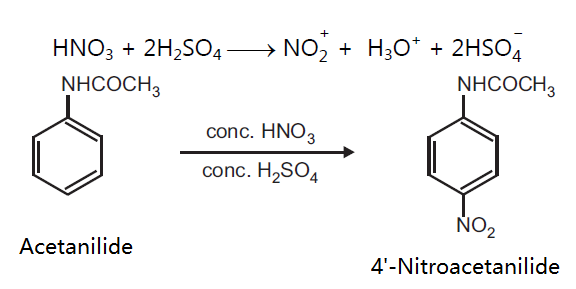4'-Nitroacetanilid
|
|
|
- CAS-Nr.
- 104-04-1
- Bezeichnung:
- 4'-Nitroacetanilid
- Englisch Name:
- 4'-Nitroacetanilide
- Synonyma:
- NSC 1315;P-NITROACETANILIDE;p-nitro-acetanilid;4-NITROACETANILIDE;4'-NITROACETANILIDE;4'-Nitroacetanilide;Acetanilide, p-nitro-;acetanilide,4’-nitro-;4-Nitroacetanilide 98%;LABOTEST-BB LT00455738
- CBNumber:
- CB1191136
- Summenformel:
- C8H8N2O3
- Molgewicht:
- 180.16
- MOL-Datei:
- 104-04-1.mol
|
4'-Nitroacetanilid Eigenschaften
- Schmelzpunkt:
- 213-215 °C(lit.)
- Siedepunkt:
- 312.97°C (rough estimate)
- Dichte
- 1.340
- Brechungsindex
- 1.6180 (estimate)
- storage temp.
- Store below +30°C.
- Löslichkeit
- 2.2g/l
- pka
- 13.91±0.70(Predicted)
- Aggregatzustand
- Solid
- Farbe
- Yellow to green-yellow or green-brown
- Wasserlöslichkeit
- 2.2g/L(room temperature)
- Merck
- 14,6581
- BRN
- 2211962
- Stabilität:
- Stable. Combustible. Incompatible with strong oxidizing agents.
- CAS Datenbank
- 104-04-1(CAS DataBase Reference)
- EPA chemische Informationen
- Acetamide, N-(4-nitrophenyl)- (104-04-1)
Sicherheit
- Risiko- und Sicherheitserklärung
- Gefahreninformationscode (GHS)
| Kennzeichnung gefährlicher |
Xi |
|
|
| R-Sätze: |
36/37/38 |
|
|
| S-Sätze: |
26-36 |
|
|
| WGK Germany |
3 |
|
|
| RTECS-Nr. |
AE5075000 |
|
|
| TSCA |
Yes |
|
|
| HS Code |
29242990 |
|
|
| Toxizität |
rat,LDLo,intraperitoneal,500mg/kg (500mg/kg),National Academy of Sciences, National Research Council, Chemical-Biological Coordination Center, Review. Vol. 5, Pg. 10, 1953. |
|
|
| Bildanzeige (GHS) |

|
| Alarmwort |
Warnung |
| Gefahrenhinweise |
| Code |
Gefahrenhinweise |
Gefahrenklasse |
Abteilung |
Alarmwort |
Symbol |
P-Code |
| H315 |
Verursacht Hautreizungen. |
Hautreizung |
Kategorie 2 |
Warnung |
![GHS hazard pictograms]() src="/GHS07.jpg" width="20" height="20" /> src="/GHS07.jpg" width="20" height="20" /> |
P264, P280, P302+P352, P321,P332+P313, P362 |
| H319 |
Verursacht schwere Augenreizung. |
Schwere Augenreizung |
Kategorie 2 |
Warnung |
![GHS hazard pictograms]() src="/GHS07.jpg" width="20" height="20" /> src="/GHS07.jpg" width="20" height="20" /> |
P264, P280, P305+P351+P338,P337+P313P |
| H335 |
Kann die Atemwege reizen. |
Spezifische Zielorgan-Toxizität (einmalige Exposition) |
Kategorie 3 (Atemwegsreizung) |
Warnung |
![GHS hazard pictograms]() src="/GHS07.jpg" width="20" height="20" /> src="/GHS07.jpg" width="20" height="20" /> |
|
|
| Sicherheit |
| P261 |
Einatmen von Staub vermeiden. |
| P264 |
Nach Gebrauch gründlich waschen. |
| P264 |
Nach Gebrauch gründlich waschen. |
| P271 |
Nur im Freien oder in gut belüfteten Räumen verwenden. |
| P280 |
Schutzhandschuhe/Schutzkleidung/Augenschutz tragen. |
| P302+P352 |
BEI BERÜHRUNG MIT DER HAUT: Mit viel Wasser/... (Hersteller kann, falls zweckmäßig, ein Reinigungsmittel angeben oder, wenn Wasser eindeutig ungeeignet ist, ein alternatives Mittel empfehlen) waschen. |
| P305+P351+P338 |
BEI KONTAKT MIT DEN AUGEN: Einige Minuten lang behutsam mit Wasser spülen. Eventuell vorhandene Kontaktlinsen nach Möglichkeit entfernen. Weiter spülen. |
|
4'-Nitroacetanilid Chemische Eigenschaften,Einsatz,Produktion Methoden
R-Sätze Betriebsanweisung:
R36/37/38:Reizt die Augen, die Atmungsorgane und die Haut.
S-Sätze Betriebsanweisung:
S26:Bei Berührung mit den Augen sofort gründlich mit Wasser abspülen und Arzt konsultieren.
S36:DE: Bei der Arbeit geeignete Schutzkleidung tragen.
Chemische Eigenschaften
solid
Verwenden
Manufacture of nitraniline.
synthetische
Preparation of 4'-Nitroacetanilide from acetanilide.
Principle: Aromatic compounds can be conveniently nitrated by the use of the nitrating mixture, which is normally a mixture of concentrated nitric acid and concentrated sulphuric acid. The function of sulphuric acid is to convert nitric acid into a highly reactive, electrophilic, nitronium ion, NO2+, which is the effective nitrating agent. Nitration of activated aromatic compounds is carried out under milder condition whereas deactivated rings require drastic conditions. Activating groups are o, p-directing, while deactivating groups are m-directing for electrophilic substitution.
Reaction:

Procedure: Take 0.5 g acetanilide in 0.6 ml glacial acetic acid and add 1 ml conc. H2SO4 in a beaker. Cool the mixture in ice salt bath (5-10°C). To this add a mixture of 0.2 ml conc. H2SO4 and 0.25 ml conc. HNO3 dropwise. Maintain the temperature below 10°C during addition. After addition is over allow the mixture to attain room temperature and leave it for 30 minutes. Pour the mixture on to crushed ice (20 g) with stirring. Filter the separated product and wash with cold water. Dry the product, record the practical yield and re-crystallize it.
Re-crystallization: Dissolve the crude product in minimum amount of ethyl alcohol in a beaker by heating on a water bath. Filter the hot solution and cool the filtrate. The crystals of the product separate out. Filter, dry and record the melting point and TLC (using toluene as solvent).
läuterung methode
Precipitate the anilide from 80% H2SO4 by adding ice, then wash with water, and crystallise from aqueous EtOH. Dry it in air. [Beilstein 12 IV 1632.]
4'-Nitroacetanilid Upstream-Materialien And Downstream Produkte
Upstream-Materialien
Downstream Produkte
4'-Nitroacetanilid Anbieter Lieferant Produzent Hersteller Vertrieb Händler.
Global( 195)Lieferanten
104-04-1(4'-Nitroacetanilid)Verwandte Suche:
- P-NITROACETANILIDE
- N-ACETYL-4-NITROANILINE
- 4-Nitroacetanilide, GC 97%
- LABOTEST-BB LT00455738
- p-nitro-acetanilid
- p-Nitrophenylacetanilide
- 4μ-Nitroacetanilide, Acetic acid 4-nitroanilide
- 4'-Nitroacetanilide,97%,pract.
- 4-(Acetylamino)nitrobenzene
- NSC 1315
- 4-Nitroacetanilide 98%
- 4''-NITROACETANILIDE 99+%
- 1-Nitro-4-acetylaminobenzene
- 4'-NITROACETANILIDE
- 4-NITROACETANILIDE
- ACETIC ACID 4-NITROANILIDE
- Acetamide, N-(4-nitrophenyl)-
- acetamide,N-(4-nitrophenyl)-
- Acetanilide, 4'-nitro-
- Acetanilide, p-nitro-
- acetanilide,4’-nitro-
- n-(4-nitrophenyl)-acetamid
- N-(4-Nitrophenyl)acetamide
- N-(4-Nitrophenyl)aceticacidamide
- N-(p-Nitrophenyl)acetamide
- N-Acetyl-4-nitrobenzenamine
- N-Acetyl-p-nitroaniline
- p-Acetamidonitrobenzene
- Pera nitro Acetanilide
- 4'-Nitroacetanilide>
- 4'-NITROACETANILIDE FOR SYNTHESIS
- 104-04-1 C8H8N2O3 4'-NITROACETANILIDE
- ParaNitro ACETANILIDE (PNA)
- 4'-Nitroacetanilide
- 104-04-1
- Building Blocks
- Nitrogen Compounds
- Organic Building Blocks
- Protected Amines
- Intermediates of Dyes and Pigments
- Aromatic Carboxylic Acids, Amides, Anilides, Anhydrides & Salts
- Anilines, Amides & Amines
- Nitro Compounds

